|
|
|
|
 PAGE THREE OF FOUR PAGE THREE OF FOUR

1 | 2 |  | 4 | 4

MONKEY IN JAPAN
PAGE THREE - JAPAN MONKEY LORE
Calculating and intelligent, yet
mischievous, vain, and restless.
Akin to the human spirit and passions.
Common motif in Buddhist art & literature.
ORIGINS
India: Hindu Lore (Pre-Buddhist) & Buddhism
China: Zodiac Lore (Pre-Buddhist) & Buddhism
Japan: Buddhist and Shintō Lore
INTRO PAGE THREE. JAPANESE MONKEY LORE.
Monkey lore in Japan resonates with deep Chinese undertones and strong Shintō overtones. These are blended together into a hybrid symphony of Buddhist beliefs and practices, making Japanese monkey lore a very complex, confusing, curious, and challenging topic -- a topic that stretches back to Japan’s first encounters with Chinese Geomancy, Chinese Taoism, the Zodiac Calendar, and Mahayana Buddhism. This page presents a wide array of Japanese ideograms, folk beliefs, and artwork about the monkey, with a special emphasis on the monkey’s close association with early Japanese Tendai Shintō-Buddhism. By the time Buddhism reaches Japan (mid-6th century AD), the monkey and monkey lore are already common elements in Buddhist legend, art, and iconography in India, China, and mainland Asia (see Monkey Page Two). Thereafter, monkey worship in Japan grows greatly in popularity, especially among practitioners of Taoist Kōshin rites introduced from China and among followers of Tendai Shintō-Buddhism, the latter centered around the syncretic Tendai shrine-temple multiplex located at Mt. Hiei 比叡 (Shiga Prefecture, near Kyoto).
|
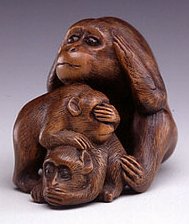
Three Monkeys
Netsuke, Boxwood
Late 19th Century
H = 1.25 inches (3.2 cm)
Courtesy asianart.com
|
|
 Some scholars believe the famous three monkeys -- speak no evil, hear no evil, see no evil -- originated in Japan in association with the Mt. Hiei multiplex and the sacred monkey of the Hie Shrine (Hie Jinja 日吉神社; also called Hiyoshi Taisha 日吉大社). The central deity at Mt. Hiei is SANNŌ (lit. = Mountain King 山王). Sannō’s messenger (tsukai 使い) and avatar (gongen 権現) is the monkey. The Sannō deity is broadly conceived, for Sannō actually represents three Buddhas (Shaka, Yakushi, and Amida), who in turn represent the three most important Shintō KAMI (deities) of Hie Shrine. These three Kami are Omiya (大宮), Ninomiya (二宮), and Shōshinshi (聖真子). All six are considered to be manifestations of the Sannō deity. Collectively, there are 21 Sannō deities at Mt. Hiei, each associated with a specific Buddhist counterpart. The manifestations of the Sannō deity are called “Hie Sannō Gongen” (日吉山王権現 Mountain King Avatars of Hie Shrine) -- gongen means “avatar,” and the most common form of this avatar is the monkey. Moreover, the number three is of tremendous importance in Tendai doctrine. This all supports the notion (still contested) that the three-monkey motif originated in Japan in association with Mt. Hiei and its Tendai Shintō-Buddhist traditions. Some scholars believe the famous three monkeys -- speak no evil, hear no evil, see no evil -- originated in Japan in association with the Mt. Hiei multiplex and the sacred monkey of the Hie Shrine (Hie Jinja 日吉神社; also called Hiyoshi Taisha 日吉大社). The central deity at Mt. Hiei is SANNŌ (lit. = Mountain King 山王). Sannō’s messenger (tsukai 使い) and avatar (gongen 権現) is the monkey. The Sannō deity is broadly conceived, for Sannō actually represents three Buddhas (Shaka, Yakushi, and Amida), who in turn represent the three most important Shintō KAMI (deities) of Hie Shrine. These three Kami are Omiya (大宮), Ninomiya (二宮), and Shōshinshi (聖真子). All six are considered to be manifestations of the Sannō deity. Collectively, there are 21 Sannō deities at Mt. Hiei, each associated with a specific Buddhist counterpart. The manifestations of the Sannō deity are called “Hie Sannō Gongen” (日吉山王権現 Mountain King Avatars of Hie Shrine) -- gongen means “avatar,” and the most common form of this avatar is the monkey. Moreover, the number three is of tremendous importance in Tendai doctrine. This all supports the notion (still contested) that the three-monkey motif originated in Japan in association with Mt. Hiei and its Tendai Shintō-Buddhist traditions.
Monkey worship in Japan peaked in the Edo Era, and has declined significantly since then. Even so, the legacy of monkey faith is easily spotted in modern Japan. One can still find centuries-old stone statues with monkey motifs in many Japanese localities -- statues weathering away, unprotected from the elements, more than 300 years in age. Photos of these statues are presented below, and links to outside sites featuring many more images are listed on Page Four. Moreover, even today, certain Japanese shrines and temples continue to perform the Kōshin rites (sleepless vigil associated with the monkey) for those who still believe (most are elderly Japanese), and red-colored lucky charms featuring the monkey can still be bought at many Japanese temples, shrines, and trinket shops.

 WORD PLAY #1 WORD PLAY #1
MONKEY AS DEMON QUELLER
猿 = Monkey (Jp. = Saru) and 去る = Expel (Jp. = Saru)
Monkey lore in Japan (and fox lore too) is closely related to Chinese geomancy (Ch: feng shui), a system for determining auspicious or inauspicious placements and orientations of cities, temples, houses, and graves. In Chinese thought, the northeast quarter is considered to be particularly inauspicious. The northeast direction is known as the “demon gate,” which can be loosely translated as the place where “demons gather and enter.” This belief was imported by the Japanese and is referred to as Kimon 鬼門 (literally “Demon Gate”). Kimon generally means ominous direction, or taboo direction. In Japan, both the monkey and the fox are guardians against evil Kimon influences.
In Japan, the monkey’s role in guarding against demons originates from the Japanese word for monkey (猿, pronounced saru), which is a homonym for the Japanese word “expel” (去る, also pronounced saru). The latter word means to “dispel, punch out, push away, beat away." According to the legends of Japan’s Mt. Hiei shrine-temple multiplex, this makes the monkey an “expeller of demons” -- in other traditions, the monkey is also thought to ward off thieves. In addition, Mt. Hiei proved to be a very fortunate choice for Saicho, 最澄 (766-822 AD), the founder of Tendai Buddhism in Japan, for the Tendai sect’s main temple (Enryakuji) on Mt. Hiei is located to the northeast of the old imperial capital (Kyoto). According to Chinese geomantic views then popular at the Japanese court (early Heian Era), Kyoto was thought to be particularly vulnerable to evil influences from the northeast. The success of Saicho and Tendai Buddhism in Japan is thus related, in part, to the geomantic significance of Mt. Hiei’s location northeast of Kyoto. The success of monkey lore in Japan is likewise partly due to this association. At the Hie Shrine (Hie Jinja 日吉神社; also called Hiyoshi Taisha 日吉大社) on Mt. Hiei, the protective monkey is named MASARU 神猿 (マサル).
|
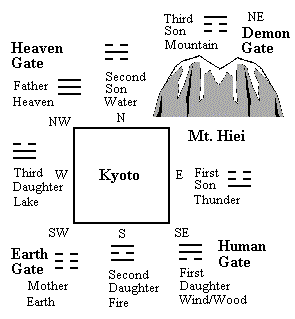
Chart Courtesy of Professor Kelley L. Ross
Says Professor Ross (see chart above; courtesy his site). The arrangement of the I Ching trigrams (Book of Changes, China) around the compass reflects Chinese geomancy (feng shui), i.e., the determination of the auspicious or inauspicious situation and orientation of cities, temples, houses, or graves. Chinese cities are properly laid out as squares, with gates in the middle of the sides facing due north, east, south, and west. The diagonal directions are then regarded as special "spirit" gates -- northwest is the Heaven Gate; southwest the Earth Gate; southeast the Man Gate; and northeast the Demon Gate. The northeast was thus the direction from which malevolent supernatural influences might particularly be expected. The situation of the old Japanese capital city of Kyoto is particularly fortunate. To the northeast is a conspicuous, twin-peaked mountain, Mt. Hiei (corresponding to the Mountain trigram), which is crowned with a vast establishment of Shinto shrines and Buddhist temples to guard the Demon Gate. <end quote by Prof. Ross> Please visit the Zodiac page for more on I Ching trigrams and Chinese yin-yang dualism.
|
|
|

Masaru
The demon queller
Photo from shrine site
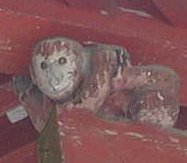
Munamochi-saru 棟持猿
Pillar-Supporting Monkey
Nishimoto Shrine (Mt Hiei)
Photo from shrine site
|
|
 MASARU 神猿 MASARU 神猿
Literally “Kami Monkey.” Masaru is the sacred monkey and protector of the Hie Shrine (aka Hie Jinja 日吉神社, Hiyoshi Taisha 日吉大社). The term “Masura” is often translated as “excel,” reflecting the belief that this sacred monkey can overcome all obstacles and prevail against all evil. Masaru is thus considered a demon queller par excellence (魔が去る・何よりも勝る). In the Heian era, Masaru (also translated “Great Monkey”) was invoked in Kōshin rituals to stop the three worms from escaping the body. Masaru also appears in Japanese scrolls used in Koushin rites.
MUNAMOCHI-SARU 棟持猿
Literally “pillar-supporting monkey.” The buildings at some Hie shrines in Japan use monkey carvings to hold up the beams (see photo at right). These pillar monkeys reflect the simian’s traditional role in Japan as protector against evil. The Hie (Hiyoshi) shrine rose to national importance in the 7th century when Emperor Tenji 天智 moved the capital to Outsu and invited the kami (Oumononushi no kami 大物主神) to act as the guardian deity of the new imperial residence. The shrine and its affiliate shrines (about 3,800 nationwide today) then became intimately linked to the Tendai Buddhist sect at Mt. Hiei -- Hie shrines are typically built in proximity to Tendai temples and serve to protect these temples. This helped greatly to ensure the shrine’s national importance during most of Japan’s medieval period.

WORD PLAY #2
MONKEY AS MANIFESTATION OF SHINTO KAMI
The Japanese character for KAMI 神 (lit. Shintō deity, spirit, god, or force) is composed of two elements. When separated, the two elements mean “Manifestation Monkey.” This explanation is attributed to the Tendai shrine-temple multiplex on Mt. Hiei. The central deity at Mt. Hiei is SANNOU (Mountain King). It should come as no surprise, then, to learn that Sannou’s messenger and avatar is the monkey.

Another version of KAMI - MONKEY word play
NEZARU 寝ざる (literally “avoid sleep, sleepless, no sleep”)
1. NERU 寝 is the word for sleep; word stem is read “ne” ネ
2. ZARU ざる means “not;” a homophone for monkey 申 (saru)
3. Combining ネ and 申 (1 + 2) yields the term KAMI 神
Thus, once again, monkeys are manifestations of Shinto kami.
This particular word play is closely associated with
the “sleepless vigil” observed in Kōshin rituals.

WORD PLAY #3
MOUNTAIN KING SANNOU
SANNOU’S MESSENGER IS THE MONKEY
IMPORTANCE OF NUMBER THREE
Without doubt, the strongest connection between the monkey and Shintō-Buddhism in Japan originates with the Japanese Tendai sect, established on Mt. Hiei by Saichō 最澄 (766-822 AD). The central deity at Mt. Hiei is SANNŌ or SANNO or SANNOU (lit. = Mountain King 山王). Sannō’s messenger (tsukai 使い) is the monkey. The Sannō deity is broadly conceived, for Sannō actually represents three Buddhas (Shaka, Yakushi, and Amida), who in turn represent the three most important Shintō KAMI (deities) of Hie Shrine. These three Kami are Omiya (大宮), Ninomiya (二宮), and Shōshinshi (聖真子). The ideograms for MOUNTAIN and KING both reflect the syncretism of the Tendai tradition and the importance of the number three in Tendai traditions. The home of China’s Tientai (Jp. = Tendai) sect was on Mt. Tientai (天台山, literally “heavenly terraced mountain”). This name, moreover, is attributed to the mountain’s location below a three-star constellation north of the Big Dipper in Ursa Major. The three stars are known as the Three Terraces or Three Platforms (三台, Jp. = Sandai), and were considered a symbolic staircase connecting heaven to the earth. The overwhelming predominance of the number three in Tendai circles is probably, therefore, the origin of Japan’s three-monkey symbolism (see no evil, hear no evil, speak no evil).
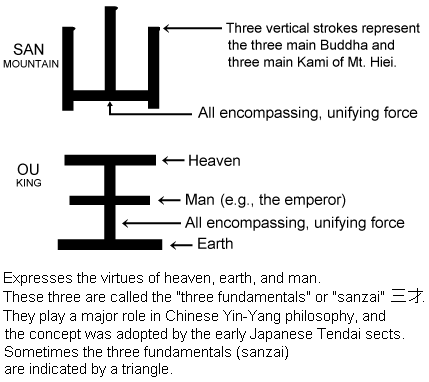
|
 NOTE ONE. The conventional spelling for this mountain deity is SANNŌ (or Sanno). Based on modern rules for romanizing Japanese terms, however, the deity’s name should be spelled “Sanou” (or Sano) -- without two Ns. For the sake of consistency, this web site uses the conventional spelling, retaining the double Ns. NOTE ONE. The conventional spelling for this mountain deity is SANNŌ (or Sanno). Based on modern rules for romanizing Japanese terms, however, the deity’s name should be spelled “Sanou” (or Sano) -- without two Ns. For the sake of consistency, this web site uses the conventional spelling, retaining the double Ns.
NOTE TWO: The Tendai shrine-temple multiplex on Mt. Hiei is a prime example of the syncretic merging of Buddhist and Shinto deities in Japan. The idea of KAMI as Gohoujin 護法神 (guardian deities of the Buddhist doctrine) was a common element in the Heian period. This Shinto-Buddhist syncretism was actually formalized and pursued based on a theory called Honji Suijaku 本地垂迹, with the Buddhist deities regarded as the honji (original manifestation) and the Shinto kami as their suijaku (incarnations). Another similar term denoting the association between Buddhas and Kami is Shinbutsu Shuugou (神仏習合). Furthermore, one resource identifies the "honji" of Sannou (Mountain King) as Ichiji Kinrin Butchou (the central Buddha of the "Court of the Perfected" (Jp. Soshitujibu). Click here for more details.
|
|

 LEGEND OF SANNŌ (SANNO). Saichō (Saicho, 最澄, 766-822 AD), the founder of the Tendai Sect in Japan, was walking on Mt. Obie 小比叡 (alternate names Ushio 牛尾, Hamo 波母, Hachiouji 八王子) within the Hiyoshi (Hie) Shrine boundaries, when the three main buddhas of Enryakuji Temple -- Shaka, Yakushi, and Amida -- appeared in the sky before him. When Saicho requested their names, they answered: LEGEND OF SANNŌ (SANNO). Saichō (Saicho, 最澄, 766-822 AD), the founder of the Tendai Sect in Japan, was walking on Mt. Obie 小比叡 (alternate names Ushio 牛尾, Hamo 波母, Hachiouji 八王子) within the Hiyoshi (Hie) Shrine boundaries, when the three main buddhas of Enryakuji Temple -- Shaka, Yakushi, and Amida -- appeared in the sky before him. When Saicho requested their names, they answered:
“Draw one horizontal stroke along the side of three vertical strokes, and to three horizontal strokes add one vertical stroke. We (I) come to this mountain in order to keep the teaching of the law of the Perfect (= Tendai) Sect within the sect, and to further the means of salvation for those outside.” With these words the Great Master (Saicho) set this up in characters. Drawing one horizontal stroke along the side of three vertical strokes he got the character SAN 山 (mountain), and when he added one vertical stroke to three horizontal strokes he got the character OU 王 (king). Thinking it must be a name, since mountain expresses a form both large and immovable and king expresses the virtues in the three fundamentals (sanzai 三才) of heaven, earth, and man, he worshipped the deity there as SANNOU. As Mt. Hiei expresses the three teachings (三学) he built three temples, and because human beings can perceive three thousand realms in one thought (ichinen sanzen 一念三千) he made three thousand the number of monks (shuto 衆徒). <End quote from Saru no Soshi; article in Japanese Journal of Religious Studies, 1996 23/1-2, by Lone Takeuchi.>
NOTE: The three main Buddha -- Shaka, Yakushi, and Amida -- were also associated with the “Days of Dharma,” which are divided into three periods -- the period of Correct Law (Age of Shobo 正法), the period of the Copied Law (Age of Zoho 象法), and the period of the Decline of the Law (the Age of Mappo 末法). Elsewhere, the classic Chinese tale Journey to the West makes numberous references to the number three. The number is of great significance in Hindu, Chinese, and Buddhist lore, and is not specific to Japan.
 OTHER LEGENDS ABOUT SANNŌ'S ORIGINS OTHER LEGENDS ABOUT SANNŌ'S ORIGINS
The name SANNŌ was given to the original Japanese mountain deity Ōyamagui (Ouyamagui) 大山咋 by the Japanese monk Saichō 最澄 (766-822 AD) when he returned from China where he had been studying, and is thought to come from the Chinese god who protected Mount Tientai 天台 in China (Mt. Tientai, Zhejiang Province, China). It was here, in China, that the Chinese monk Chisha (Chigi) Daishi 智顗大師 (538 - 597 AD) founded the original Tientai (Ch. = Tientai; Jp. = Tendai) school of Buddhism. According to Chinese legend, this holy mountain is located below a three-star constellation named Sandaisei (三台星), which lies north of the Big Dipper in Ursa Major. These stars supposedly guarded the heavens surrounding the North Star -- which the Chinese regard as the home of the “Lord of the Heavens.” There are other interpretations, mind you. One source says that SANNOU was named after the tutelary deity "Perfected Lord, Mountain King Yuanbi" (Ch. Shanwang Yuanbi Zhenjun) at Guoqingsi Temple on Mt. Tientai in China. The same source identifies the seven main shrines of Hie Jinja with the stars of the "Big Dipper" -- according to this interpretation, which is considered accurate among scholars, these stars control the destiny of individual humans.
Nine Evil Monkeys; Dream of King Kriki 訖哩枳王 (Jp: Kiriki-ou)
Adapted from Soka Gakkai Web Page. Saicho, the founder of Tendai Buddhism in Japan, makes reference to the nine bad monkeys chasing away the one good monkey in his Kenkairon Engi (early 9th century AD). Saicho venerated, in part, the teachings of the Lotus Sutra, the basis of the “perfect teaching” -- a pillar of Tendai thought in Japan. The perfect teaching was derived from the doctrine of the Single Vehicle in the Lotus Sutra, and teaches that “all sentient beings are bodhisattvas, and all can become buddhas.”

Kōshin
also read
Kanoe Saru.
57th Year
in Zodiac
60-year Cycle
Homophone


Means
Exchange of
the Gods


Saru
Monkey
Homophone


Means “not” |
|
 WORD PLAY #4 WORD PLAY #4
KOUSHIN, THREE WORMS, THREE MONKEYS
In Japan, certain Zodiac days-years of great misfortune are known as Kōshin 庚申 (Ch: keng-shen or geng-shen). Koushin days occur six times yearly, and the Koushin year is the 57th year in the 60-year cycle of the Zodiac calendar. On these days (year), special rites -- influenced greatly by Chinese Taoist beliefs involving three worms believed to inhabit the body -- are performed to ward off evil influences. A major player in Kōshin rituals is the monkey, for the term Koushin 庚申 is comprised of two characters -- KOU 庚, the Chinese zodiac stem associated with metal and the planet Venus, and SHIN 申, the ninth branch symbol of the Chinese zodiac and the character for monkey.
The first year of the Zodiac’s sexagenary cycle is Koushi 申子 (Japanese reading; also read kinoe ne), and it too includes the character for monkey 申. This first year of the Zodiac calendar symbolizes “beginning and complete renewal.” Other years were given special meanings based on the sound of their Zodiac characters, which were homonyms for other terms. In China, for example, the term Gengzi 庚子 (Jp. koushi; kanoe ne) is the 37th year in the 60-year cycle. Its homophone (in Chinese) is 更孳, meaning “to change and engender” -- the Gengzi day was thus regarded as the most auspicious day for producing offspring. In similar fashion, the Japanese pronunciation of Kōshin 庚申 (the inauspicious 57th year of the cycle, closely associated with the monkey) is a homophone for Koushin 更神, meaning “exchange of the gods.” Says Professor Livia Kohn of Boston University: “On the Koushin day, the spirit beings usually residing in the human body rise up to heaven, while the gods of heaven descend. It is a time of meeting and exchange. The three deathbringers (three worms) become active celestial officials, changing places with the protective deities of heaven. The latter, in turn, descend as Koushin deities -- the Three Ones, Shōmen Kongō, Taishakuten, and Sarutakiko.” <End quote from Livia Kohn>
In the same way, the association of the three monkeys with Japan’s Kōshin cult is based upon word play (it also reflects the crucial importance of the number three in Tendai cosmology and thought, as well as the three worms of Taoist traditions). The Zodiac animal associated with the Koushin day is the monkey 申. The Japanese word for monkey is “SARU.” This word is phonetically linked with the negative “ZARU,” which means “not.” Thus, the names of the three monkeys are Mizaru 見ざる (no see), Kikazaru 聞かざる (no hear), and Iwazaru 言わざる (no speak).

MONKEY DEITIES IN JAPAN
- MASARU 神猿 (lit. Kami Monkey). The sacred monkey of the Hie Shrine (aka Hie Jinja 日吉神社, Hiyoshi Taisha 日吉大社). Masaru is considered a demon queller par excellence (魔が去る・何よりも勝る). Masaru is also invoked in Kōshin rituals to stop the three worms from escaping the body.
 Details above. Details above.
- SANNŌ (SANNO, SANNOU) GONGEN 山王 権現 さんおう ごんげん
Literally “Mountain King Avatar.” Sannō means mountain king, and gongen means avatar. The monkey is Sannō’s messenger (tsukai 使い) and Sannō’s avatar (gongen). At Hie Jinja shrines in Japan, the monkey also acts as the patron of safe childbirth and harmonious marriage, and red monkey charms are used to ward off evil and disease.  Details below. Details below.
- SARUGAMI 猿神 (lit. Monkey Kami). Another term for the sacred Shintō monkey (Masaru) of Mt. Hie. Sarugami is worshipped as the deity of easy delivery and child rearing, and is the Lord of the three monkeys (see, hear, speak no evil). Closely associated with fertility.
 Details below. Details below.
- JUUZENJI 十禅師. The tutelary deity of Juuzenji Shrine, one of the 21 Sannō shrines at Mt. Hiei (Hieizan 比叡山). Juuzenji’s emissaries are monkeys.
 Details below. Details below.
- SHINRA MYŌJIN (SHINRA MYOJIN) 新羅明神. In addition to the central mountain deity named SANNŌ, the Tendai shrine-temple multiplex located at Mt. Hiei is home to another powerful mountain deity. This latter deity is known as Shinra Myoujin (also called Shiragi Myōjuin). Artwork of this deity typically shows an unusual crown which has three points, in the traditional shape of a mountain. Related also to Daruma, the patriarch of Zen Buddhism.
 Details below. Details below.
- SARUTAHIKO, SARUTABIKO, SAURTAHIKO-NO-KAMI.
猿田彦, 猿田彦神. Commonly translated as “monkey man.” The long-nosed Shintō deity of the crossroads who takes on the visage of a monkey; also considered by some to be the ancestor of the long-nosed Tengu mountain goblin. This kami is often depicted as a disheveled wanderer, and is said to protect people in the course of their lives and to ward off bad influences. Sarutahiko’s connection with Kōshin 庚申 rituals and three-monkey worship did not occur until the Edo period.  Details below. Details below.
- KŌSHIN (KOSHIN, KOUSHIN), 庚申. In Japan, certain Zodiac days/years of great misfortune are known as Kōshin 庚申 (Ch: keng-shen or geng-shen). On these days (year), special rites -- influenced greatly by Chinese Taoist rites involving three worms and nine parasites that inhabit the body -- are performed to ward off evil influences, to protect against sickness and misfortune, and to cure illness. The three monkeys (see, speak, hear no evil) are closely related to Kōshin rituals.
 Details below. Details below.

SANNŌ GONGEN 山王 権現
SARUGAMI 猿神
Fertility, Childbirth & Marriage
 Monkeys are patrons of harmonious marriage and safe childbirth at some of the 3,800 Hie Jinja shrines in Japan. These shrines are often dedicated to Sannō Gongen 山王権現 (lit. = mountain king avatar), who is a monkey. Sannō is the central deity of Japan’s Tendai Shinto-Buddhist multiplex on Mt. Hiei (Shiga Prefecture, near Kyoto). The monkey is Sannou’s Shinto messenger (tsukai 使い) and Buddhist avatar (gongen 権現). Monkeys are patrons of harmonious marriage and safe childbirth at some of the 3,800 Hie Jinja shrines in Japan. These shrines are often dedicated to Sannō Gongen 山王権現 (lit. = mountain king avatar), who is a monkey. Sannō is the central deity of Japan’s Tendai Shinto-Buddhist multiplex on Mt. Hiei (Shiga Prefecture, near Kyoto). The monkey is Sannou’s Shinto messenger (tsukai 使い) and Buddhist avatar (gongen 権現).
The monkey messenger is also known as Sarugami (猿神; literally “monkey kami”). Sarugami is the Shinto deity to whom the three monkeys (hear, speak, see no evil) are reportedly faithful. The monkey shrine at Nakayama Shrine 中山神社 in Tsuyama City, Okayama Prefecture, is dedicated to a red monkey named Sarugami, who blesses couples with children. According to shrine legends, the local people at one time offered human sacrifices (using females) to this deity. The shrine is mentioned in the Konjaku Monogatari-shu (今昔物語集), a collection of over 1000 tales from India, China, and Japan written during the late Heian Period (794-1192 AD). Sarugami, like Sannou Gongen, is also worshipped as the deity of easy delivery and child rearing. At such shrines, statues of the monkey deity are often decked in red bibs -- a color closely associated with fertility, children, and protection against evil forces and diseases like smallpox (see below).
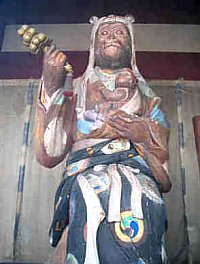 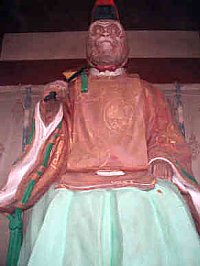
Sannou (Sanno) Gongen
Above two photos courtesy of James Baquet
Female with babe and male monkey guard the gates
at Hie Jinja (Hie Shrine), Akasaka, Tokyo, Japan
SAYS JAMES-SAN: The Hie Jinja Shrine (Tokyo) is dedicated to Sanno Gongen (山王権現), which translates literally as "Mountain King Avatar" of Sannou, the deity who dwells on Mt. Hiei between Kyoto and Lake Biwa. This is also the home mountain of the Japanese Tendai Sect (Chinese: Tien-tai). Many of Japan's 3,800 Hie Jinja shrines are built in proximity to Tendai temples, and serve to protect these temples. The female monkey on the left cradles a baby in her arms; male and female both hold implements used in Shinto rituals. The monkeys -- especially the female -- are considered the patrons of harmonious marriage and safe childbirth (my best friend Reiko was married at this shrine). <End quote by Baquet-san>

|
THE COLOR RED - Short Version
|
 In Japan, the color red is associated closely with the monkey and a few other deities in Shinto and Buddhist traditions. Click here for expanded story on RED’S symbolism. There are many clues that underpin the red association. Perhaps the most convincing clue involves disease (e.g., smallpox, scarlet fever, tuberculosis, measles) -- for red, according to Japanese folk belief, is the color associated with "expelling demons and illness.” This link segues easily into other associations with child mortality, protection against evil forces (illness), fertility, the caul (the embryonic membrane covering the head at birth), and other childbirth imagery. The red bibs, red robes, and red caps found on certain Japanese deities (see below) lend strong support to this interpretation. In Japan, the color red is associated closely with the monkey and a few other deities in Shinto and Buddhist traditions. Click here for expanded story on RED’S symbolism. There are many clues that underpin the red association. Perhaps the most convincing clue involves disease (e.g., smallpox, scarlet fever, tuberculosis, measles) -- for red, according to Japanese folk belief, is the color associated with "expelling demons and illness.” This link segues easily into other associations with child mortality, protection against evil forces (illness), fertility, the caul (the embryonic membrane covering the head at birth), and other childbirth imagery. The red bibs, red robes, and red caps found on certain Japanese deities (see below) lend strong support to this interpretation.
Briefly, the Japanese god of smallpox -- Hōsō (Hoso) Kami 疱瘡神 -- is intimately associated with the color red in Japan. The first record of smallpox in Japan appears in the Nikon Shoki (日本書紀, approx. 720 AD). But the disease reached Japan much earlier, around the time of Buddhism’s introduction (circa 550 AD). The disease was very dangerous. If the ill person’s skin turned purple, it was considered serious. But if the skin turned red, it was believed the patient would recover. This association with disease was gradually turned upside-down -- proper worship of the smallpox deity could bring salvation, while improper worship or neglect could result in death. In later centuries, the Japanese recommended that children with smallpox be clothed in red garments and that those caring for the sick also wear red (click here for details on smallpox in Japan).
Red-equals-sickness symbolism quickly gave way to a new dualism between evil and good, between death and life, between hell and heaven, with red embodying both life-creating and life-sustaining powers.
Red-colored monkey charms are used in Japan, even today, to ward off demons, evil spirits, and sickness (see Migawari-zaru below). The Japanese word for monkey (猿 saru) is a homonym for the Japanese word 去る, which means to “dispel, punch out, push away, beat away," and thus monkeys are thought to dispel evil spirits. The buildings at some Hie Shrines in Japan use monkey carvings to hold up the beams (see photo at right of Munamochi-saru 棟持猿). These pillar monkeys reflect the simian’s traditional role as protector against evil. Moreover, the monkeys worshipped at many Hie Jinja shrines in modern Japan are considered patrons of fertility, safe childbirth, and harmonious marriage. At these shrines, the monkey statues are often decked in red clothing, the color meant to symbolize fertility and childbirth. Women can even buy red underpants called Saru-mata 猿股 (lit. monkey underwear), which equates to the red buttocks of female monkeys in heat, and thus symbolizes fertility. There are approximately 3,800 Hie Shrines nationwide.
MIGAWARI-ZARU, 身代わり猿, literally "substitution monkey." This red monkey charm is hung on the eves of the house to protect the inhabitants from disasters and to block evil forces from entering the home. One doll for each person of the home is hung on the eve of the house. Said to protect sinners from punishment by Kōshin, as the monkey (Koushin’s messenger) is punished instead. Hence the name Migawari-zaru -- the substitution monkey. Still a practice found in the old part of Nara city (details here, Japanese-language site).
NEGAI-ZARU, 願い猿, literally “monkey for wishes.” Another name for the Migawari-zaru monkey charm (see above). People write their wishes on the back of this monkey charm, hang it up, and hope their wishes will be granted by the monkey deity. For a few more details about monkey charms, jump to page four. For an expanded version of the RED COLOR topic, please see the page RED IN JAPANESE MYTHOLOGY. |

JŪZENJI 十禅師
|
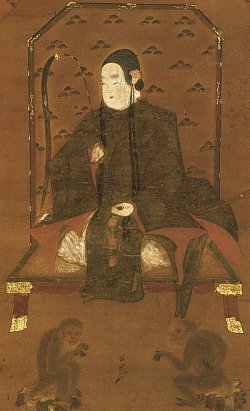
Sannō Avatar Jūzen-ji
Muromachi Period, 15th Century
Hanging Scroll, Color on Silk
Height 57.2 cm; width 25.3 cm
Enryakuji Temple, Shiga Prefecture
Photo courtesy of 2005 Exhibition Catalog
|
|
 Also known as Zenkan 禅漢. Jūzenji (Juuzenji, Juzenji) is the tutelary deity of Jūzenji Shrine, one of the 21 Sannō shrines at Mt. Hiei (Hieizan 比叡山). Jūzenji’s emissaries are monkeys. Jūzenji has various honji 本地 (Buddhist manifestations of Shinto kami), which include Jizō, Miroku, Benzaiten, and Kokūzō. Says Tendai scholar Paul Groner: Also known as Zenkan 禅漢. Jūzenji (Juuzenji, Juzenji) is the tutelary deity of Jūzenji Shrine, one of the 21 Sannō shrines at Mt. Hiei (Hieizan 比叡山). Jūzenji’s emissaries are monkeys. Jūzenji has various honji 本地 (Buddhist manifestations of Shinto kami), which include Jizō, Miroku, Benzaiten, and Kokūzō. Says Tendai scholar Paul Groner:
“The term Jūzenji 十禅師, which can be translated as Ten Meditation Masters, refers to a group of official posts awarded to monks so that they could use the powers accruing from their virtue to protect the state. Because most early Tendai zasu (head monks 座主) held one of these posts at a time when they had difficulty obtaining other official positions, the office was important in early Tendai history. Certain texts play on this meaning by claiming that the deity of Jūzenji Shrine was originally one of these masters, or that it was Emperor Kōnin, under whom the post of meditation master was established. By the time the Kankō Ruijū was composed, the Jūzenji deity was seen as one of the manifestations (gongen 権現) of the Sannō Kami, and through plays on words came to represent “Sudden-Perfect” meditation. Belief in Jūzenji became popular in the late Heian period. In one story, the monk Myōson 明尊 (971-1063 AD) received a teaching from Jūzenji about the three truths, as did the Tendai monk Chūjin 忠尋. Jūzenji is also said to have appeared in a dream to Hochibo Shoshin 宝地房証真 (1136-1220 or 1131-1215 AD). Jūzenji was disappointed when Shoshin requested worldly goods for his mother, but approved when he requested spiritual help for her.
<End quote by Paul Groner>
CITATION, JUUZENJI RESEARCH:
Japanese Journal of Religious Studies 1995 22/1-2
A Medieval Japanese Reading of the Mo-ho chih-kuan
Placing the Kankou Ruijii in Historical Context
Paul GRONER. Click here for story in PDF format.

Shinra Myōjin 新羅明神
|
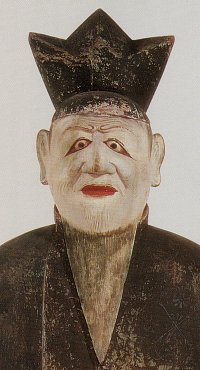
Shinra Myōjin, Miidera
Wearing three-pointed hat
in shape of mountain.
12th Century, Heian Era
Height = 78.1 cm
|
|
 In addition to the central mountain deity named Sannō, the Tendai shrine-temple multiplex located at Mt. Hiei is home to another powerful mountain deity. This latter deity, known as Shinra Myōjin (also called Shiragi Myōjuin 新羅明寿院, Shinra Zenjin 新羅善神, Sekizan Myōjin 赤山明神, Matara-shin 摩多羅神) was brought to Japan from China. Shinra Myōjin was first encountered in China by the Tendai monks Ennin 円仁 (794-864 AD) and Enchin 円珍 (814-891 AD) and then introduced to Japan. There is some confusion as to the deity’s exact origin, however, as the term Shiragi (also read Shinra) was the name for Korea’s Silla kingdom during those centuries. Yet, most sources trace Shinra Myōjin’s origin back to China. The Sannō tradition, moreover, refers to this deity in non-Japan settings -- as the protector of Tiantai-shan 天台山 in China and of Vulture Peak 靈山 in India. Other traditions say he is the mountain god of Sung-shan 嵩山 in China, where the Zen patriarch Daruma reportedly achieved enlightenment. In addition to the central mountain deity named Sannō, the Tendai shrine-temple multiplex located at Mt. Hiei is home to another powerful mountain deity. This latter deity, known as Shinra Myōjin (also called Shiragi Myōjuin 新羅明寿院, Shinra Zenjin 新羅善神, Sekizan Myōjin 赤山明神, Matara-shin 摩多羅神) was brought to Japan from China. Shinra Myōjin was first encountered in China by the Tendai monks Ennin 円仁 (794-864 AD) and Enchin 円珍 (814-891 AD) and then introduced to Japan. There is some confusion as to the deity’s exact origin, however, as the term Shiragi (also read Shinra) was the name for Korea’s Silla kingdom during those centuries. Yet, most sources trace Shinra Myōjin’s origin back to China. The Sannō tradition, moreover, refers to this deity in non-Japan settings -- as the protector of Tiantai-shan 天台山 in China and of Vulture Peak 靈山 in India. Other traditions say he is the mountain god of Sung-shan 嵩山 in China, where the Zen patriarch Daruma reportedly achieved enlightenment.
Shinra Myōjin 新羅明神
Below text courtesy JAANUS.
The deity that protects Miidera 三井寺 at the eastern foot of Mt Hiei 比叡 in Shiga prefecture. Legend has it that when when Enchin 円珍 (814-891), the founder of Miidera, returned from from China where he had been studying Buddhism, an old man appeared in his boat and said, "I am Shinra Myoujin," and promised to protect the Buddhist Dharma (Buddhist Law) for Enchin. Thus, Shinra Myoujin was enshrined as the protective deity of Miidera. The best known image of the deity is the sculpture in the Shinra Zenjindou 新羅善神堂 in the precincts of Miidera in which he appears seated, wearing court robes and an unusual crown which has three points, in the traditional shape of a mountain (see above photo). He also sports a long pointed beard. Shinra Myoujin's Chinese origin is emphasized when he is represented in the guise of a Chinese official, as he is in a painting owned by Miidera (see photo below). In this work he is seated on a chair, holding a scroll and a staff (shakujō 錫杖), accompanied by two young male attendants (douji 童子), whose names are Shukuō 宿王 and Hannya 般若. Also present is Hinomiko 火御子, the protective deity of the earth (Jinushigami 地主神).

Shinra Myōjin 新羅明神
|
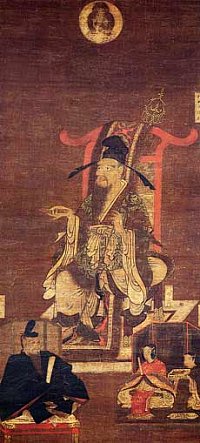
Shinra Myōjin
Miidera, Scroll
Kamakura Era, 13th C.
H 86.7 cm, W 39.4 cm
Photo courtesy Miidera
|
|
 Below text (abridged); courtesy Bernard Faure, professor at Stanford University and author of numerous books on Buddhism. Below text (abridged); courtesy Bernard Faure, professor at Stanford University and author of numerous books on Buddhism.
Shinra Myōjin (Myojin) is the tutelary deity of Miidera. This mysterious god is traced back to the mountain god of Song (Sung) Shan 嵩山 in China, who dwelt in a cave on that mountain, and who became an epidemic god. This mountain god is given other names, one of which is King of Sung Shan, and he is said to have manifested himself a number of times in China to expel pestilence demons. His main temple was a cave at Sung Shan, the same cave, apparently, where Bodhidharma (Daruma) allegedly sat for nine years in meditation. Shinra Myoojin is also associated with the Shinto deity Susanoo. In some sources, the latter, after being exiled from Japan for having threatened his sister Amatarasu, is said to have emigrated to Korea. Susanoo was also assimilated with Gozu Tennou, the most powerful epidemic god. Like Shinra Myoojin, Susanoo is a fundamentally ambivalent deity, who could protect from epidemics when worshipped properly, but could as well destroy unbelievers through the same epidemics. Thus, the priests of Miidera held this veiled threat over the heads of the ruler and his people. This is how the emperor died for having brought on himself the anger of Raigou, a Miidera priest whose resentful spirit (onryou) was apparented to Shinra Myoojin. According to one legend, Susanoo manifested himself in China as the god of Song Shan. He first appeared to the Japanese priest Enchin (the monks who founded Miidera and introduced Shinra Myoojin) as a theriomorphic figure, with a man’s head and a snake’s body. As such, he calls to mind Ugajin, a god associated with the dragon-goddess Benzaiten. <End abridged quote from Bernard Faure>
Shinra Myoujin 新羅明神
Other Manifestations - Matarajin 摩多羅神
Courtesy of Dr. Gabi Greve
One of the most common manifestations of Shinra Myoujin is the deity Matarajin 摩多羅神 (also known as Madarajin まだらじん, Matara-Shin またらしん, Mathara, Mahakala, Mahaakaala). This deity was introduced to Japan from China by the Japanese Tendai monk Ennin -- Jikaku Daishi Ennin 慈覚大師仁円 -- as a protector deity of the Amida Sutra (Amida Kyou 阿弥陀経). Some say Matarajin is also the secretary of Enmaten, the main judge of Buddhist Hell. Since the Heian Period, Matarajin has been venerated at temples of the Tendai sect of Esoteric Buddhism. He was the main deity for certain secret rituals (Genshi Kimyoudan 玄旨帰命壇、 げんしきみょうだん) of the Tendai sect at the Jougyoudou Hall 常行堂 (じょうぎょうどう) on Mt. Hiei (Hieizan 比叡山) where many statues of him were made. During the Genroku Period (1688-1704 AD) these rituals were abolished at Mt. Hiei and most of the statues destroyed. He is the tutelary deity of the temple Miidera 三井寺, where he is known as Shinra Myoujin. For more details on other manifestations of Matarajin, please see page of Dr. Gabi Greve.
Professor Bernard Faure (Stanford University)
Courtesy Daruma, Smallpox and the Color Red
Quote 1: The Daruma cult calls to mind that of the "back door" (ushirodo) of Japanese Buddhist temples, dedicated to Matarajin or similar deities, protectors with a dubious past or an ambivalent nature. Quote 2: My hypothesis is that Daruma came to be perceived, in circumstances that remain obscure, as such a placenta deity — a god which was often described as “the warp and woof of heaven and earth.” The demiurgic of this deity explains its identification with the stellar god of the “fundamental destiny” (honmyoo), that is, the Polar Star. This is for instance the case with Matarajin, which, as Suzuki Masataka has shown, was one of the main aspects of a “god of destiny” [shukushin], both astral and embryological deity, governing life on both macrocosmic and microcosmic, astral and uterine planes. <end quotes by Bernard Faure>

SARUTAHIKO 猿田彦, 猿田彦神
 Also written SARUTABIKO, SARUTAHIKO-NO-KAMI. Commonly translated as “monkey man.” The long-nosed Shinto deity of the crossroads who takes on the visage of a monkey; also considered by some to be the ancestor of the long-nosed Tengu mountain goblin. Also written SARUTABIKO, SARUTAHIKO-NO-KAMI. Commonly translated as “monkey man.” The long-nosed Shinto deity of the crossroads who takes on the visage of a monkey; also considered by some to be the ancestor of the long-nosed Tengu mountain goblin.
The celestial Shinto goddess Ame-no-Uzume-no-Mikoto (天宇受売命; the “terrible female of heaven”) was the first to meet the earthly kami named Sarutahiko. She determines that he is not an enemy, after which he guides Ninigi 彦火瓊瓊杵尊 and other Shinto deities on their descent from heaven to earth. She is accorded honors by Ninigi for her encounter with Sarutahiko -- she becomes the founder and head of the Sarume Order of sacred Shinto dancers, for she and her lineage are henceforth christened Sarume-no-Kimi (猿女の君 monkey women). Writes W.G. Aston: "The Sarume were primarily women who performed comic dances (saru-mahi, 猿樂, monkey dances) in honor of the Shinto Gods. They are mentioned along with the Nakatomi and Imbe as taking part in the festival of first-fruits and other Shinto ceremonies. These dances were the origin of the Kagura 神楽 and the No performances" <end Aston quote> Another modern name for the monkey dances is 猿神の舞い.
Sarutahiko and Sarume-no-Kimi are both personified in medieval kagura 神楽 dances and sarugaku 申楽 shows, and even today appear in popular forms of entertainment. Ame-no-Uzume, moreover, is the same Shinto goddess whose erotic and humorous dance prompted Amaterasu to come out from her cave to bring light back into the world. Click here (outside site) for more on Shinto mythology found in the Kojiki 古事記 (Japan's oldest surviving text; 712 AD) and the Nihongi 日本紀 (Chronicles of Japan; 797 AD).

SARUTAHIKO’S DEATH
Below text courtesy
Encyclopedia of Shinto
Sarutahiko is an earthly Shinto kami who went out to the "eight crossroads of heaven" to meet and act as guide to the heavenly Ninigi (aka Hiko-ho-no-ninigi no Mikoto 彦火瓊瓊杵尊, the August Grandchild of Heaven) at the time of Ninigi’s descent to earth. Sarutahiko was described as having a fantastic appearance, with a nose seven spans long, a height of over seven feet, and with eyes that glowed red like a mirror. Since the goddess kami Ame no Uzume 天宇受売命 was the first to confront Sarutahiko, Ninigi granted to her the clan title Sarume no Kimi 猿女の君 (monkey woman). After acting as guide to Ninigi, Sarutahiko arrived at the upper reaches of the Isuzu River in Ise, where the Kojiki 古事記 (Records of Ancient Matters; Japan's oldest surviving text; 712 AD) records that his hand became trapped inside a large clam at Azaka, and he thus drowned. He is considered the ancestor of the Ujitoko clan in Ise, and the central object of worship (saijin) at the Sarutahiko Shrine 猿田彦神社 located in Ise, Mie Prefecture. During the Tokugawa period, he was also adopted as the "ancestor of teaching" in the school of Suika Shinto. <end quote by Kadoya Atsushi, Encyclopedia of Shinto>
SARUTAHIKO, SANNOU, AND BUDDHISM
Sarutahiko’s connection with the Koushin 庚申 ritual and three-monkey worship did not occur until the Edo period, which reflects the growing importance of Shinto beliefs during the Edo era. Nonetheless, Sarutahiko appears in earlier legends surrounding SANNOU 山王, the mountain king and central deity of the the Tendai Shinto-Buddhist multiplex at Mt. Hiei. In the Scroll of the Monkey (猿の草子), produced sometime around 1570 AD, the longest passage is called the Hiei Engi (比叡縁起), which discusses the origin of Buddhist practice on Mt. Hiei.
First, Shaka (the Historical Buddha), while still living in the Tosotsu-ten (兜率天, Skt: Tusita; Buddhist heaven), creates the land in which he intends to propagate the Buddhist doctrine after his appearance in this world. Second, at the time of Ugaya Fukiaezu no Mikoto (鵜草葺不合尊; the father of Emperor Jinmu 神武), Shaka obtains the land at the foot of Mt. Hiei from an old fisherman at the intervention of Yakushi Nyorai. Shirahige (白髭), the old fisherman, the Shinto kami who has to yield his land to Shaka, is none other than Sarutahiko-no-kami (猿田彦神), who in the myths of the Kojiki 古事記 meets Hiko-ho-no-ninigi no Mikoto (彦火瓊瓊杵尊) then on his descent from the heavens) and pledges to guide him on his way. Third, around the year 800 AD, SANNOU is revealed to Saichou 最澄, the founder of the Tendai sect. <Above paragraph quoted from article entitled Saru no Soshi in the Japanese Journal of Religious Studies 1996 23/1-2. Story by Lone Takeuchi.>
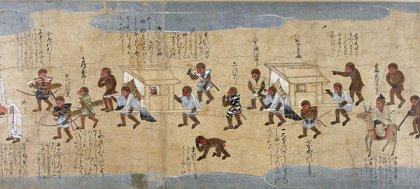
Saru no Soshi (猿の草子 Scroll of the Monkey)
Late 16th Century, One Section of the Japanese Scroll
Photo courtesy of British Museum, where the scroll is kept.

|
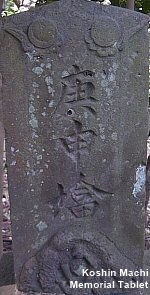
|
|
Kōshin Machi 庚申會 Tablet. At Kōshin services in Japan, various rituals take place in front of a tablet or scroll that shows the written name or image of the Kōshin deity.
|
|
 KŌSHIN 庚申, KŌSHIN MACHI 庚申會 KŌSHIN 庚申, KŌSHIN MACHI 庚申會
THREE WORMS 三蟲, NINE PARASITES 九蟲
In Japan, certain Zodiac days/years of great misfortune are known as Kōshin 庚申 (Ch: keng-shen or geng-shen). Also spelled Koshin or Koushin, such days occur six times yearly, and also occur on the Kōshin year (the 57th year in the 60-year Zodiac cycle). On these days (year), special rites -- influenced greatly by Chinese Taoist rites involving three worms and nine parasites that inhabit the body, but now an entirely Buddhist ritual in Japan -- are performed to ward off evil influences, to protect against sickness and misfortune, and to cure illness. A major player in Kōshin rituals is the monkey, for the term Kōshin 庚申 is comprised of two characters -- KŌ 庚, the Chinese Zodiac stem associated with metal and the planet Venus, and SHIN 申, the ninth branch symbol of the Zodiac; also the character for monkey. Another key player in Kōshin rituals is Shōmen Kongō, a multi-armed esoteric (tantric) deity often depicted in artwork standing atop three monkeys.
In Taoist traditions from China, first documented in the 4th century AD, on the night before a Kōshin Day, THREE WORMS (三蟲; also called three corpses / deathbringers 三尸) believed to dwell in the human body escape from the body and visit the Court of Destiny 司命 (ruled by the Emperor of Heaven 天帝) to report on the sleeping person's sins. Depending on this report, the Court of Destiny might decide to shorten the individual's life. To prevent this, people stayed awake on Kōshin nights (the eve of the Kōshin day), gathered around scrolls of Shōmen Kongō. This practice eventually became known, in Japan, as the Kōshin Machi 庚申會 (Kōshin Vigil, Kōshin Wake, Kōshin Gathering).
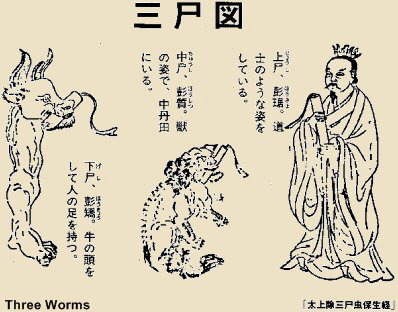
The Three Worms as depicted in the Baosheng Jing, a Chinese document, early 4th Century AD. Another group of
parasites, known as the NINE WORMS 九蟲, work together actively with the THREE WORMS to cause sickness.
|
 QUOTE FROM BAOUPUZI (CHINA, 320 AD) QUOTE FROM BAOUPUZI (CHINA, 320 AD)
On every Kōshin day, the three worms ascend to heaven and file a report on our misdeeds with the Department of Destiny. Similarly during the last night of the month, the Stove God makes a journey to heaven and reports on our behavior. For the more important misdeeds, three hundred days are deducted from our lives. For lesser sins, three days are deducted from our lives. < Source: Livia Kohn >
|
|
The first Kōshin ritual in Japan supposedly occurred during the reign of Mommu (697-707 AD), the 42nd emperor. This is recorded in documents held by the Shitennōji Temple in Osaka (but these documents are from the late Muromachi period). Another early reference to the Koushin practice occurs in the Shoku Nihon Kōki 続日本古紀 (Nihon Koki) of 834 AD. These and other early accounts do not mention the three worms, nor even the presence of the monkey -- but the monkey’s presence is implied owing to its connection to the zodiac animal of the Kōshin day. Kōshin practices are also mentioned in late Heian-era documents, including the Kōshin Scripture 庚申経, the Kanke Monju 菅家文集, and a poem by Emperor Murakami (984-987 AD). <Source Livia Kohn>
Although the exact origin of the Kōshin ritual in Japan is uncertain, it is quite probable that Kōshin practices were first brought to Japan by early Tendai monks who had visited China (e.g., Saichō, 最澄, 766-822 AD; Ennin 円仁 794-864 AD; and Enchin 円珍 814-891 AD) and returned home with Chinese medical texts that contained details on this Taoist practice. Many of these Chinese documents are cited in subsequent court/temple records, yet none of these early documents mention the three monkeys. This site, therefore, assumes that the three monkeys are a Japanese innovation.
|
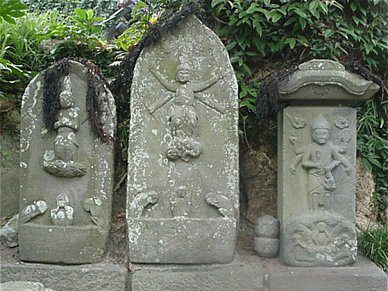
|
|
Kōshin stone tablets depicting Shōmen Kongō atop three monkeys
Outside Yakumo (Yagumo) Shrine in Kamakura, Japan.
Three monkeys are shown near the base of each piece.
(L) 1692 AD, Six-armed Shōmen Kongō, Kōshin Statue
(M) 1680 AD, Four-armed Shōmen Kongō, Kōshin Statue
(R) 1808 AD, Six-armed Shōmen Kongō, Kōshin Statue
|
|
 In the Kamakura period, the Kōshin cult was popularized by the Japanese Tendai sect, and became closely associated with the Tantric deity named Shōmen Kongō. It achieved further popularity during the Muromachi period, when the first Kōshin Engi 庚申縁起 (local accounts) were written, and remained very popular through the Edo Era (1600-1868 AD), by which time the Kōshin rites became associated with the Shintō kami Sarutahiko. Kōshin belief was particularly widespread during Japan's Edo period, when people regularly tried to determine auspicious (good) or inauspicious (bad) times before beginning activities such as a new business, marriage or other ventures. In the Kamakura period, the Kōshin cult was popularized by the Japanese Tendai sect, and became closely associated with the Tantric deity named Shōmen Kongō. It achieved further popularity during the Muromachi period, when the first Kōshin Engi 庚申縁起 (local accounts) were written, and remained very popular through the Edo Era (1600-1868 AD), by which time the Kōshin rites became associated with the Shintō kami Sarutahiko. Kōshin belief was particularly widespread during Japan's Edo period, when people regularly tried to determine auspicious (good) or inauspicious (bad) times before beginning activities such as a new business, marriage or other ventures.
Over the centuries, numerous stone steles and tablets were erected in Japan to commemorate the Kōshin practice <see above photo>. Hundreds of such statues (dating from the mid-17th century onward) can still be found in modern Japan. See page four for list of sites featuring and cataloging Japan’s many Kōshin statues.
|
|
|
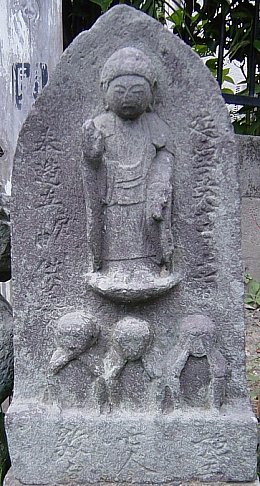
1677 AD, Kōshin Stone Tablet
Amida Nyorai Standing Atop Three Monkeys
Entrance to Tenen Hiking Course, Kamakura. Of the many statues mapped and cataloged in Japan, the deities most commonly shown atop three monkeys are:
Shōmen Kongō, Sarutahiko, Taishakuten, Dainichi,
Amida, Shaka, Yakushi, Kannon, and Jizō.
|
|
UNPROTECTED FROM THE WEATHER. Kōshin stone statues are often unprotected from the elements. Hundreds (possibly thousands) of such statues remain throughout Japan, but many more were destroyed in the early Meiji era, when a general ban of roadside shrines was issued and roads were widened everywhere. To save and protect these statues, local communities often collected the statues and clustered them around important shrine precincts in each specific neighborhood. Many of these statues are designated as “Important Cultural Properties” in the localities where they are located. But in most cases, these statues were never provided a permanent shelter against the elements -- thus, most suffer from the impact of rain, temperature variation, and the steady onslaught of moss.
DEITIES ATOP THE THREE MONKEYS. The three monkeys appear most frequently in Kōshin stone statues dating from the mid-Edo period. The earliest surviving Kōshin tablet is dated 1375 AD (Yamagata Prefecture; source), but it does not depict any monkeys. Of the many statues mapped and cataloged in Japan, the deities most commonly shown atop the three monkeys are: Shōmen Kongō, Sarutahiko, Taishakuten, Dainichi, Amida, Shaka, Yakushi, Kannon, and Jizō. <source www.kcn-net.org >
TAISHAKUTEN. In Japan, the Nichiren Sect is the only sect to integrate the Kōshin ritual with worship of the Buddhist deity Taishakuten (Hindu = Indra). Another major deity in Kōshin rituals, Shōmen Kongō, is often depicted in artwork with four demon attendants called the Shikumon Setsuki 四句文刹鬼. These four are said to be wrathful manifestations (Jp. = Keshin 化身) of Taishakuten. |

SHŌMEN KONGŌ (SHOMEN KONGO) 青面金剛
Also known as Seishoku Daikongō Yasha 青色大金剛薬叉
Blue-Faced Vajrapani, East, Blue, Powers of Healing
(Sometimes read Seimen Kongō)
In the Kamakura period, the Kōshin cult was popularized by the Japanese Tendai sect, and became closely associated with the Tantric deity named Shōmen Kongō (Shomen Kongo). This link between Kōshin and Shōmen Kongō depends largely on the healing powers of the latter, including Shōmen’s powers against various illnesses and demons, against attacks by strange creatures, eye diseases, breathing disorders, and many other ailments. This deity first appears in the Darani Jikkyō 陀羅尼集経 of the mid-7th century AD. Japan’s oldest extant image of Shōmen Kongō is a 10th-century wooden statue at Tōdai-ji (Nara).

|
|
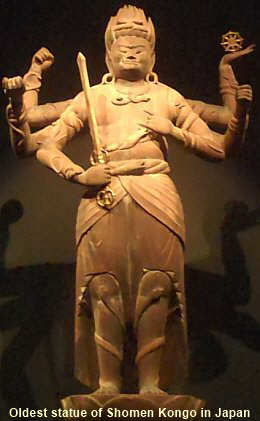
Six-Armed Shōmen Kongō
Wood with polychromy
Heian Period, 10th Century
Tōdai-ji Temple, Nara
Ichiboku Zukuri 一木造. Single-Block Carving.
Oldest extant image in Japan of this deity.
Photo taken at exhibit at the
Tokyo National Museum. TNM classifies
Shōmen Kongō as a Shintō deity.
|
|
|
|
|
 Says JAANUS Says JAANUS
about Shōmen Kongō
A deity who protects against diseases believed to be caused by demons. Shoumen Kongou is one of the Raksasa (or Yasha) of Hindu lore and rules the east. This deity first appears in the Darani Jikkyo (陀羅尼集経) of the mid-7th century AD. In this and other Buddhist texts, he was a demon who originally caused disease but who was then conquered and rededicated himself as a protector against disease. In some accounts, he is the king of the Yasha, and defends people especially against demons and disease. Shoumen Kongou often appears as an angry deity with a blue body and four arms. He carries a three-pronged vajra (kongousho 金剛杵) in his upper right hand, a staff (shakujou 錫杖) in his lower right hand, a wheel (Skt. cakra, Jp. rinpou 輪宝) in his upper left hand, and a coiled rope (kensaku 羂索; noose) in his lower left hand. These various implements are symbolic within Esoteric Buddhism. He may also be shown with two arms, six arms, or in other forms. He may be accompanied by two boys (douji 童子) or by four demons (see scroll below). <Editor’s Note: The blue or lapis-lazuli color symbolizes that he takes the disease and sickness of suffering beings unto himself. The Vajra (lit. = thunderbolt) is a type of weapon and sceptre, symbolizing the indestructible power of Buddhism. The Shakujou (staff) is a ritual object used often in Tendai and Shingon ceremonies; it symbolizes many things, and can be used as a weapon against evil. The Cakra (wheel) represents the Buddha's teachings, the Wheel of Dharma-Law, and is a a metaphor for teaching the way to enlightenment. The Kensaku (noose) is an ancient hunting weapon, which came to symbolize power over evil forces and demons in Buddhism throughout Asia.>
Since the Kamakura period, Shōmen Kongō, being mixed with Taoism, became a deity of the cult of Kōshin. This cult believed that on the eve of the monkey day (year), it was particularly easy to have your life shortened. In order to counteract this danger, believers stayed awake through the night and on the Kōshin day gathered before scrolls of Shōmen Kongō (in the Edo Era, they gathered before images of Sarutahiko 猿田彦) to hold a devotional celebration. They also held festivities before carvings of the set of three monkeys, "See no evil, speak no evil, hear no evil," (mizaru, kikazaru, iwazaru 見ざる、言わざる、聞かざる) who are believed to be related to the sacred monkey of Hie Jinja 日吉神社 in Shiga Pref. <end quote JAANUS>

|
Shōmen Kongō & Kōshin Machi 庚申會 Mandala
|
|
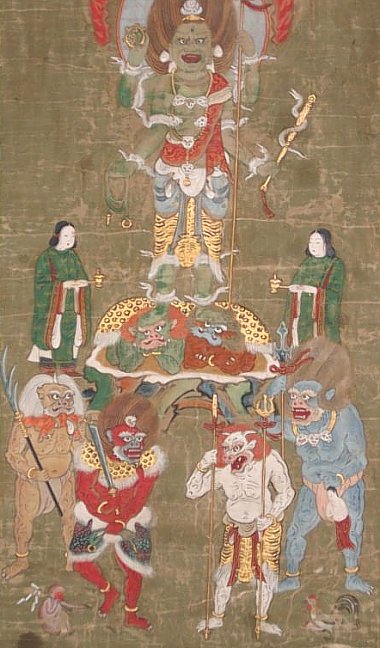
|
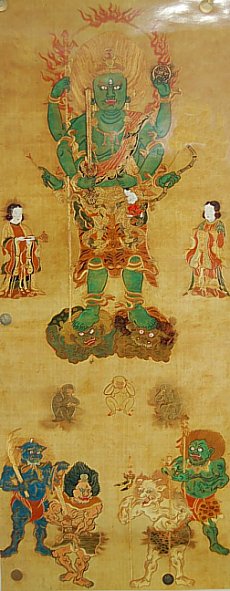
|
|
Kōshin Machi 庚申會 Mandala (date unknown).
Used for the Kōshin Vigil, Kōshin Wake, Kōshin Gathering, Kōshin Ritual. <Photo: American art collector>
Four-armed Shōmen Kongō atop two demons, and
accompanied by two youthful attendants (Dōji 童子),
four Yasha, a monkey (Masaru) and a rooster. In Japan,
the Dōji often represent the healer's helping spirit.
The four yaksa may (or may not) represent the Shima
(lit. Four Demons 四魔) who “annoy living beings,” but
most likely they represent the Shikumon Setsuki 四句文刹鬼 (Raksha Ogres of Four Phrases). See notes below.
|
Kōshin Machi 庚申會 Mandala, Shitennō-ji Temple. Today, Shitennō-ji in Osaka is the largest, oldest, and most revered site for Kōshin rituals in Japan, and its Kōshin Hall still performs the Kōshin rites six times each year. During the Kōshin rituals at this temple, believers are gathered before scrolls of Shōmen Kongō and pummeled, from head to legs, with a wooden monkey figurine, which apparently ensures future health. The basic rules for Kōshin participants are: do not speak evil, do not use bad language, do not get angry, do not get caught up in passion, do not think evil thoughts, do not think of sex, do not eat the flesh of animals that have four feet or two feet, and do not touch the five strong-smelling vegetables. Says Livia Kohn: “Modern-day Kōshin rituals are inalienably Buddhist, having long ago lost their Taoist origins.” Photo from Shitennō-ji poster; see J-listing of upcoming Kōshin rituals
|
|
|
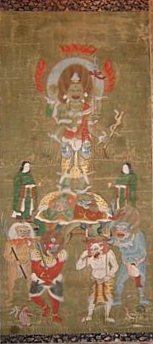
|
|
Kōshin Machi 庚申會 Mandala. Same as the prior photo.
See prior photo for details.
|
|
 Notes on Above Shōmen Kongō Scrolls Notes on Above Shōmen Kongō Scrolls
- The Darani Jikkyō 陀羅尼集経 of the mid-7th century AD says: His feet stand on two crouching demons. To his right and left, there are two attendants. They are clad in blue (green) and hold incense burners. Before him on his right, there are two yaksa. One holds a sword; the other holds a rope. The first is yellow; the second is red. Before him on his left, there are two more yaksa. One holds a lance; the other holds a trident. This first is black; the second is white.
The above scrolls deviate only slightly from each other and from the text of the Darani Kikkyō. Yaksa (Jp. = Yasha) are Hindu spirits who act as protectors in Buddhism. One of the Dōji 童子 (attendants) might be named Shōkera. In Buddhist tradition, many deities have two acolytes, one benevolent, the other punishing evil. Shōkera punishes evil, for if he finds people asleep, he allows the three worms to go about their harmful business. <Source Livia Kohn>. The blue (black?) Yasha above is holding a sinner.
- Monkey & Rooster in Above Scroll. The two most likely act as protectors to dispel evil. At Hie Jinja shrines and other shrines even today, both the monkey and the rooster can be found guarding the entrance gates to the shrines. Most shrines, however, are guarded by a pair of shishi (lions) or foxes. Buddhist temples are typically guarded by the Niō Protectors. The rooster’s exact significance, however, is unknown to me. Perhaps the rooster acts as the herald of sunrise, thus giving notice that the Kōshin threat has passed. Yet, in the Zodiac, the Hour of the Rooster is at sunset. The rooster is the 10th branch zodiac animal (monkey is 9th). In Wheel of Life paintings, the rooster symbolizes desire.
- Yaksa or Rasetsu Demons in Above Scroll. The four demon attendants appearing in the above scrolls may (or may not) represent the Shima 四魔 (four demons who annoy living beings), but most likely they represent the Shikumon Setsuki 四句文刹鬼. Both groups are presented below.
|
Shima 四魔
Four kinds of demon (Skt. = māra) who annoy living beings. Below list presents their Sanskrit spelling followed by Chinese characters and Japanese reading. Textual descriptions courtesy of the Digital Dictionary of Buddhism.
- Kleśa-māra 煩惱魔, Jp. = Bonnōma. The demon of ill desires who injures one's body and mind.
- Skandha-māra 陰魔, Jp. = Onma 陰魔. The demon of aggregates. The five elemental aggregates of body, perception, conception, volition, and consciousness cause living beings many kinds of suffering.
- Mṛtya-māra 死魔, Jp. = Shima. The demon of death, who cuts off the lives of all living beings.
- Devaputramāra 天子魔, Jp. = Tenshima. The demon named Paranirmita-vasa-vartin (他化自在天), who is the king of the sixth heaven in the world of desire and who tries to prevent living beings from doing good.
(Skt. catur-māra, catvāro mārāḥ; cattāro mārā) 〔瑜伽論 T 1579.30.447c17〕
Source: Digital Dictionary of Buddhism
Sign in with user name = guest
|
Shikumon Setsuki 四句文刹鬼
Rasetsu (Ogres) of the Four Phrases / Verses. Setsuki 刹鬼 is another term for Rasetsu. These four Rasetsu (Skt. = Rākṣasa) embody the gāthā 偈 or 伽陀 -- verses that generally consist of four lines of Chinese characters. Shikumon 四句文 means “four phrases, or four verses.” It refers to four terms of logic or differentiation (Skt. = Catuṣkoṭi) which are A, not A, both A and not A, and neither A nor not A. The four Rasetsu in Japan, along with their colors and meaning, are presented below. Their colors deviate slightly from above scroll.
- Shogyō Mujō (Shogyo Mujo) 諸行無常. Blue. Considered a manifestation of Shōmen Kongō. All phenomenon are impermanent, all is transient.
- Zeshō Meppō (Zesho Meppo) 是生滅法. Red. All that arises will be extinguished; all will cease to exist. Death comes to us all.
- Shōmetsu Metsui 生滅滅已. Black. When the law of arising & ceasing comes to an end....
- Jakumetsu Iraku 寂滅為楽. Color of Flesh. The bliss of nirvana comes with the end of arising & ceasing.
Sources:
|
|
Translation of Above Four-Lined Shikumon 四句文 Verses
|
|
Sho gyō mu jō = 諸行無常
Ze shō meppō = 是生滅法
Shō metsu metsu i 生滅滅已
Jaku metsu i raku 寂滅為楽
|
All phenomena are impermanent
They are subject to the law of origination & perishing
When origination & perishing comes to an end
Calm will be found to be the true happiness.
|
|
<Source: The Creed Of Half Japan: Historical Sketches Of Japanese Buddhism. By Arthur Lloyd (published 1911).
These four verses correspond to the Four Noble Truths (Jp. = Shitai 四諦) taught by the Historical Buddha. They are:
(1) Life is suffering (Jp. = Kutai 苦諦), (2) Suffering has cause (Jp. = Jittai 集諦), (3) Eliminate cause and thereby
eliminate suffering (Jp. = Mettai 滅諦), and (4) Learn and pursue the eightfold path to enlightenment (Jp. = Dōtai 道諦).
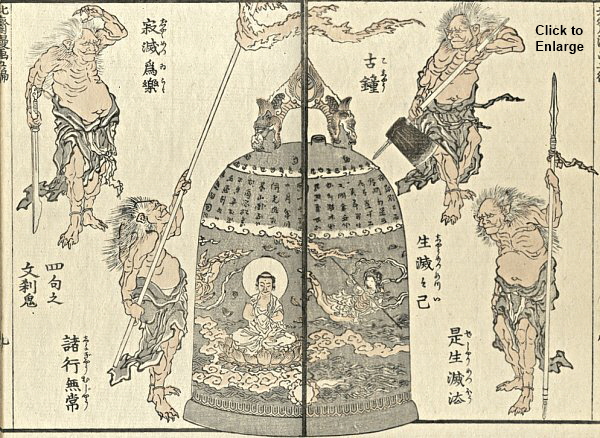
Shikumon Setsuki 四句文刹鬼 (the Four Rasetsu)
As portrayed by Hokusai Katsushika 葛飾北斎 (1760-1849), one of
Japan's best-known artists, in Manga Vol. 5. 葛飾北斎の漫画本第五編.
Photo courtesy Professor Evgeny Steiner (SOAS), from a never-before published copy
of Manga Vol. 5. Steiner is working on a complete facsimile Manga edition with commentary.
In the Butsuzō-zu-i 仏像図彙 (expanded Meiji-era reprint of original 1690 document), these four Rasetsu are said to be manifestations (Jp. = Keshin 化身) of Taishakuten, and to embody the four verses mentioned in the early 5th-century Chinese translation of the Great Nirvana Sutra 大般涅槃經 (Jp. = Daihan Nehan Kyō, Skt. = Mahāyāna Mahāparinirvāṇa Sūtra). Their fierce appearances and weapons are given in the 26th chapter of the Lotus Sutra 法華経陀羅尼品.
|
|

|
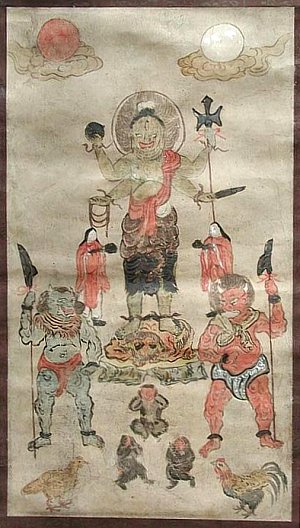
|
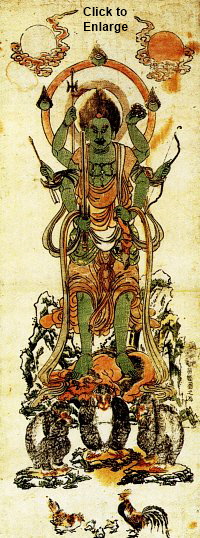
|
|
17th Century Folk Painting (Scroll) of Shōmen Kongō.
See prior photo for notes on iconography.
Photo from Richard Mellott. See his comments below.
Available for online purchase at Richard Mellott Antiques.
|
Shōmen Kongō. Dated between 1779 to 1794.
By Hokusai 北斎 (1760-1849). Click to enlarge.
See prior photo for notes on iconography.
Photo: 日本の美をめぐる (No. 1, April 30, 2002)
|
|
|
Says Mellott-san about the above 17-century folk painting: “A rare, museum quality, Japanese folk painting of Shōmen Kongō (or KŌSHIN) dating to the 17th century. It is a hanging scroll with colors on paper. Typical of this type of painting, some of the outlines (monkeys and chickens) of the figures were first block-printed on the paper and then colors added with a brushed to complete the painting. The mounting, which has been professionally restored in Japan, is the original one with gold-printed flowers on a gray hand-made paper ground. The actual painting measures 12 3/4 inches in height and 7 3/4 inches in width. The overall scroll is 26 inches in height and 10 1/2 inches in width.”

Shōmen Kongō Scrolls in the collection of Emil & Anneke Schuttenhelm
Visit their site for numerous photos. Shōmen Kongō Scrolls | Homepage
|
|

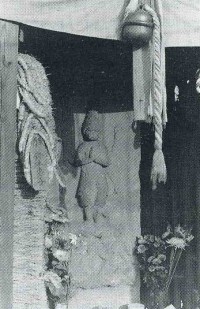 Below Text & Photo Courtesy: Below Text & Photo Courtesy:
Buddhism: Flammarion
Iconographic Guides
by Louis Frederic
Printed in France, 1995
ISBN 2-08013-558-9
In popular custom, Shōmen Kongō is offered large straw sandals (waraji 草鞋) because he is thought to wear out many shoes during his long journeys in pursuit of the wicked and of demons.

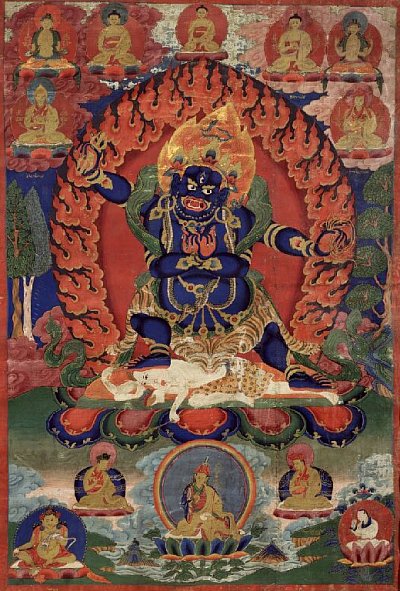
Vajrapani Bhutadamara (Modern Tibetan Painting). (English: Vajra Holder, Subduer of Demons).
This deity is worshipped in Tibet, and has attributes very similar to Shōmen Kongō in Japan.
Photo courtesy himalayanart.org/image.cfm/64.html. Please see above site for text by Jeff Watts.

SUN AND MOON SYMBOLS 左右に日月を彫り
Found often on Kōshin (Koshin) statues with three monkeys. The Moon symbol is called Gachirin 月輪 (also Gatsurin or Getsurin). It is a perfectly round circle meant to represent the full moon, a frequently used symbol in Buddhist painting and sculpture. It represents the Buddha's knowledge and virtue, and it symbolizes the aspirations of sentient beings hoping to attain Buddhahood. It also symbolizes the circular and luminous nature of the enlightened mind. The Gachirin is a defining attribute of Gakkō Bosatsu, who is often shown in statues/paintings wearing a headpiece representing the moon or holding a circular moon-shape in his hand. The Gachirin is also found often on Buddhist grave stones called Gorinto. The moon and sun are part of the traditional Chinese yin-yang theory of balance and contrast. The moon is used as a symbol of adversities or obstacles. In contrast, the sun symbolizes hope, for even though a moon eclipse may block the sun’s light, there is always a portion of the sun that shines through. The Buddhist deity Nikkō Bosatsu represents sunlight, as does Dainichi Nyorai (Solar God, Cosmic Lord).
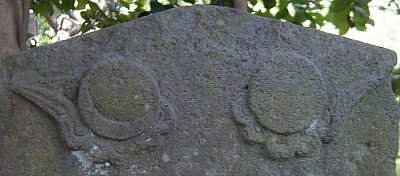
Found often on Kōshin stone statues.
Sun’s Eclipse on Left, Full Moon on Right.

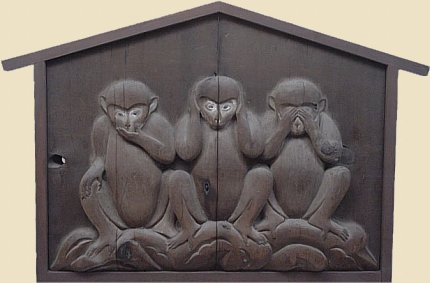
Wood Carving, 1646 AD
Speak No Evil, Hear No Evil, See No Evil
Iwazaru, Kikazaru, Mizaru = 言わざる、聞かざる、見ざる
San-en = Three Monkeys = 三猿
Treasure of Hase Dera Temple in Kamakura, Japan
THREE MONKEYS
There is no agreement on the origin of the three-monkey motif. Is it from India, China, Korea, or Japan? This site assumes that the three-monkey motif is an innovation attributed to Japan‘s Tendai sect. The motif may have developed from the Three-Kami-Three-Buddha-Formula of Japanese Tendai Buddhism at Mt. Hiei, or possibly from the core Tendai principle of triple truth 三学, i.e., (1) all things are void and without essential reality; (2) all things have a temporal or provisional reality; (3) all things are both absolutely unreal and provisionally real at the same time. Alternatively, the three monkeys might represent the Three Truths of Buddhism, which are: (1) life is suffering; (2) suffering is caused by our desires, and; (3) eliminate desire and thereby eliminate suffering. Or perhaps it stems from the three-star constellation named Sandaisei (三台星) after which the Tendai sect itself is named. But most probably (in my mind), the three monkeys are a Japanese innovation associated with the three worms of the Taoist Kōshin ritual (from China, but latter adapted by the Japanese). The number three is very important to Buddhists in India, China, Japan, and other nations in mainland Asia (see above). There are literally dozens of other important concepts related to the number three, making it extremely hard to pinpoint the origin of the three-monkey motif. If your computer can display Japanese kanji, visit this outside site, then scroll down until you come to the section for “three.” Lots of intriguing possibilities.
At the risk of sounding the fool, I would like to submit my own interpretation. First, the Koushin ritual is most strongly linked with Shōmen Kongō, the blue-colored Yasha of Hindu lore, who is associated with the powers of healing, who represents the “east,” and who is considered the king of the Yasha. Now, let us recall that Saicho himself, the founder of Tendai Buddhism in Japan, carved various statues of the Yakushi Nyorai (the Buddha of Healing and Medicine) during his lifetime. Yakushi Nyorai is associated with the color “blue” and represents the “east.” Yakushi Nyorai, furthermore, is protected by 12 Yasha Generals, who represent the 12 vows of Yakushi Nyorai. These 12 Generals are constantly waging war on illness and disease. They originate in Hindu lore, but later become protectors of the Buddhist Law. These 12 Yasha Generals wear effigies of the 12 Zodiac animals in their headdresses.
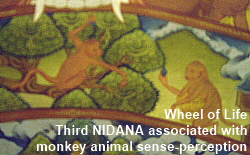 3 + 9 = 12 3 + 9 = 12
Might not the association between KOUSHIN and SHOUMEN KONGOU originate here? The number three (three monkeys) plus the number nine (the nine monkeys in King Kriki’s dream mentioned in Saicho’s writings; the nine halls Saicho ordered constructed at Enryakuji Temple) equals twelve. The three worms and nine parasites in the Taoist Koushin ritual also add up to twelve, and 12 Yasha protect Yakushi Nyorai, the Buddha of Medicine and Healing. Moreover, the Historical Buddha spoke of the Twelve Causes of Suffering, and in many Wheel of Life (Thanka) paintings, the doctrine of the 12 Nidana (Skt., 12-linked Chain of Causation) is painted around the wheel. The third nidana is Vinnyana, or awareness. It symbolizes animal sense-perception, and is depicted as a monkey climbing a tree.
There is other overwhelming evidence for the YAKUSHI connection. There are a total of 21 shrines at Mt. Hiei, known as the “21 Sannou Group” (Sannou Nijuuissha 山王二十一社). These 21 shrines are split into three groups of seven -- the three groupings represent the three main Buddha/Kami of the Tendai complex, who are Shaka, Yakushi, and Amida. They in turn represent the three most important Shinto KAMI (deities) of the Hie shrine complex. These three Kami are Omiya (大宮), Ninomiya (二宮), and Shoushinshi (聖真子). The so-called Upper Seven Sannou Shrines (Sannou Kami no Shichisha 山王上七社) form the core of the Sannou complex. They are associated with Shaka, are known as The Big Hiei group, and are associated with the seven stars of the Big Dipper. The next group of seven shrines, known as The Little Hiei group, is associated with Yakushi Nyorai. Furthermore, Yakushi traditionally assumes seven different forms as a healer. These forms are known as the “Seven Emanation Bodies of Yakushi,” which are described in various Sanskrit and Chinese texts. A list of all seven manifestations can be found here.
Thus, in my mind, the association of the three monkeys with the Kōshin ritual (three worms, nine parasites, equals 12); the invocations to the healer Shōmen Kongō (blue, east, king of the Yasha); the importance of the number three (and seven) in Tendai tradition; Saicho’s long-standing patronage of Yakushi (blue, east, Medicine Buddha, protected by 12 Yasha, lord of the “Little Hiei” group of seven shrines) -- all this fits tightly together into a systematic pattern of faith and devotion directed toward Yakushi Nyorai, the Buddha of Medicine and Healing.
I may be wrong, but in my research on Tendai beliefs, the above interpretation sounds very “believable” -- and the evidence presented here is hard to dismiss as mere coincidence. Thus, I prefer my own “unproved” interpretation over the “standard” interpretation found at most web sites devoted to monkey lore. These sites, without citing references, claim the three monkeys originated in China and India. I believe this is wrong -- the three monkeys are mostly likely a Japanese innovation.
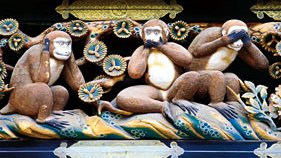 3 Monkey Artwork 3 Monkey Artwork
The most famous carving of the three monkeys ("hear no evil, speak no evil, and see no evil") is found at the 17th-century Toshogu Shrine, a complex built to honor Tokugawa Ieyasu, the founder of the Tokugawa Shogunate (1603-1868 AD). The carving is located on the eaves of the shrine’s sacred stable (Shinkyusha), and reflects the monkey’s role as Protector of the Stable, a role that originated in the Chinese novel Journey to the West.

MORE DETAILS ON ORIGIN OF SANNŌ 山王 さんおう
MOUNTAIN KING SANNŌ (SANNO, SANO, SANNOU, SANOO)
Sanskrit = Parvata-raja; Tibetan = Ri'i rgyal po.
Below text courtesy of JAANUS. Hie Sannousha 日吉山王社 (also called Hiyoshi Sannousha), a shrine at the foot of Mt Hiei 比叡 in Sakamoto 坂本 in Shiga Prefecture. The name SANNOU was given to the original deity Ōyamagui 大山咋 (Ouyamagui, Oyamagui) by the monk Saichō 最澄 (766-822 AD) when he returned from China where he had been studying, and apparently comes from the Chinese god who protected Mount Tientai 天台 (Jp: Tendai). As at many other shrines, the name of the deity served as his collective name and as the name of the shrine. Sannou Mandala 山王曼荼羅. Also known as the Hie Sannou Mandala 日吉山王曼荼羅. A class of Shinto devotional paintings having to do with Hie Sannousha 日吉山王社 (also popularly called Hiyoshi Sannousha), a shrine at the foot of Mt Hiei 比叡 in Sakamoto 坂本 in Shiga Prefecture.
There are a total of twenty one shrines at the site known collectively as the Sannō Nijūissha 山王二十一社 but also split into three groups of seven. The first of these is the Upper Seven Sannou Shrines (Sannō Kami no Shichisha 山王上七社) which forms the core of Sannō. It comprises four sanctuaries in the eastern group and three in the western group. The eastern group is dominated by the Ninomiya 二宮, where Ōyamagui (who came to be called Kobie no Kami 小比叡神, also read Kohiegami) was worshipped and the western group is led by the Ōmiya 大宮 where the deity was Ōmononushi (or Ōnamuchi 大己貴) who came to be called Ōbie no Kami 大比叡神 (also read Ohiegami). Both of these kami are mentioned in the KOJIKI 古事記 (712 AD). Ōyamagui was the original presence, and Ōmonushi was brought from Mt. Miwa 三輪 in 668 AD by the Emperor Tenji 天智 (626-671 AD), whose capital was in Ōtsu 大津. These seven shrines are associated with Tendai traditions concerning the seven stars of the Big Dipper (Hokuto Shichisei 北斗七星. The Sannō Nijūissha is completed by the Middle and Lower groups of seven shrines which are composed of more minor sanctuaries. The shrine buildings are spread over a considerable area at the foot of Mt Hiei and at the foot of a small hill called Hachiōjisan 八王子山, which is the shrine's sacred mountain (Shintaizan 神体山). At the summit of this hill, buildings are constructed around a boulder.
|
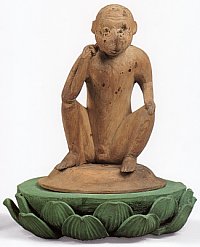
Hakusan Daigongen, Wood
12th Century, Heian Era
Height: 31.0 cm
Keisoku-ji Temple, Shiga Pref.
|
|
 In the Kamakura period the area was filled with Shinto and Buddhist buildings and could be called the One Hundred and Eight Inner and One Hundred and Eight Outer Shrines. In 788 AD Priest Saichō 最澄 called upon the deity to act as the guardian of his temple, which became Enryakuji 延暦寺. By the late 12th century the shrine and temple together formed a well developed honji suijaku 本地垂迹 complex (syncretic merger of both Buddhist and Shinto practice). The shrine's cult was particularly important to the temples on Mt Hiei, to the temples and residences in Sakamoto, and to devotional confraternities (kou 講). Like the Kasuga Cult (see Kasuga Mandala 春日曼荼羅), the Sannou cult also spread in the areas where the shrine was powerful, and branch shrines developed. The deity has a certain notoriety as the protector and religious weapon of the Enryakuji monks in the descents on the capital that began in the late 11th century. The considerable power of Enryakuji was not entirely destroyed until 1571 AD when Oda Nobunaga 織田信長 (1534-82 AD) burned the temples and scattered the monks. When the temple was reestablished, it and other temples were no longer allowed large landholdings and other economic advantages; and with all government power removed from Kyoto they also lost the advantages of having court connections. The shrine suffered again in the separation of Shinto and Buddhism (Shinbutsu Bunri 神仏分離) in early Meiji (1868 AD), losing much syncretic art. Most Sannou Mandala show the deities in their shrines, on pedestals against screens or ranged in tiers against a conventionalized landscape background, sometimes in a conceptual building (with a foundation, but without walls or a roof). Most paintings show the deities of the Upper Seven Sannou Shrines, either in their Buddhist or Shinto form. The three most revered kami as found in the Sannou Mandala are Ninomiya (whose Buddhist counterpart is Yakushi Nyorai, Oomiya (whose counterpart is Shaka Nyorai, and the Shoushinji 聖真子, whose counterpart is Amida Nyorai. Although there are paintings of both the kami and their honjibutsu (Buddhist counterparts), there do not seem to be Shaji mandala 社寺曼荼羅 (paintings of the shrine and temple together). In the Kamakura period the area was filled with Shinto and Buddhist buildings and could be called the One Hundred and Eight Inner and One Hundred and Eight Outer Shrines. In 788 AD Priest Saichō 最澄 called upon the deity to act as the guardian of his temple, which became Enryakuji 延暦寺. By the late 12th century the shrine and temple together formed a well developed honji suijaku 本地垂迹 complex (syncretic merger of both Buddhist and Shinto practice). The shrine's cult was particularly important to the temples on Mt Hiei, to the temples and residences in Sakamoto, and to devotional confraternities (kou 講). Like the Kasuga Cult (see Kasuga Mandala 春日曼荼羅), the Sannou cult also spread in the areas where the shrine was powerful, and branch shrines developed. The deity has a certain notoriety as the protector and religious weapon of the Enryakuji monks in the descents on the capital that began in the late 11th century. The considerable power of Enryakuji was not entirely destroyed until 1571 AD when Oda Nobunaga 織田信長 (1534-82 AD) burned the temples and scattered the monks. When the temple was reestablished, it and other temples were no longer allowed large landholdings and other economic advantages; and with all government power removed from Kyoto they also lost the advantages of having court connections. The shrine suffered again in the separation of Shinto and Buddhism (Shinbutsu Bunri 神仏分離) in early Meiji (1868 AD), losing much syncretic art. Most Sannou Mandala show the deities in their shrines, on pedestals against screens or ranged in tiers against a conventionalized landscape background, sometimes in a conceptual building (with a foundation, but without walls or a roof). Most paintings show the deities of the Upper Seven Sannou Shrines, either in their Buddhist or Shinto form. The three most revered kami as found in the Sannou Mandala are Ninomiya (whose Buddhist counterpart is Yakushi Nyorai, Oomiya (whose counterpart is Shaka Nyorai, and the Shoushinji 聖真子, whose counterpart is Amida Nyorai. Although there are paintings of both the kami and their honjibutsu (Buddhist counterparts), there do not seem to be Shaji mandala 社寺曼荼羅 (paintings of the shrine and temple together).
|
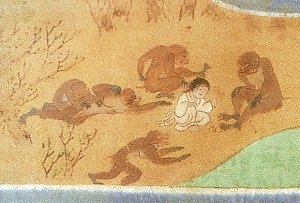
Detail, Sannou Reigenki (Handscroll)
Miracles of Sannou Shrine
Muromachi Era, 15th Century
Izumi City, Osaka Pref.
Kuboso Memorial Museum of Arts
|
|
 The Monkey is the messenger (tsukai 使い) of Sannou and can be found on the steps of buildings or in landscape paintings. Sometimes a dressed monkey deity appears among the shrine kami in paintings. Paintings of single deities are less common than in the art of the Kasuga cult, but the Shoushinji was identified with Hachiman (see JAANUS entry Sougyou Hachiman) and there are paintings of Hachiman as a youth that are called Sannou mandala. Sannou mandala were used on Mt. Hiei and in affiliated temples to express the protection of the shine and by devotional confraternities in regular meetings: they were also hung in Tendai temples for certain rituals. As with Kasuga mandala (and in contrast to Kumano mandala 熊野曼荼羅), the Sannou mandala lacks folk appeal and are most characteristically paintings of high quality dating from the Kamakura through Muromachi Periods [13c-16c]. Along with the vertical scrolls called mandala, there is also an illustrated history of the wonders of the shrine dated 1288, "Sannou Reigenki 山王霊験記" (Hie Jinja 日枝神社, Numazu 沼津, Shizuoka Prefecture), and there are screen paintings of the shrine's festival (Hie Sannou Matsuri 日吉山王祭). The first recorded instance of the making of a Sannou mandala occurs in GYOKUYOU 玉葉, the diary of Kujou Kanezane 九条兼実 (1149-1207 AD), and refers to a scroll painting of the deities. Extant paintings date from the middle of the Kamakura period (13th century). <end quote from JAANUS> The Monkey is the messenger (tsukai 使い) of Sannou and can be found on the steps of buildings or in landscape paintings. Sometimes a dressed monkey deity appears among the shrine kami in paintings. Paintings of single deities are less common than in the art of the Kasuga cult, but the Shoushinji was identified with Hachiman (see JAANUS entry Sougyou Hachiman) and there are paintings of Hachiman as a youth that are called Sannou mandala. Sannou mandala were used on Mt. Hiei and in affiliated temples to express the protection of the shine and by devotional confraternities in regular meetings: they were also hung in Tendai temples for certain rituals. As with Kasuga mandala (and in contrast to Kumano mandala 熊野曼荼羅), the Sannou mandala lacks folk appeal and are most characteristically paintings of high quality dating from the Kamakura through Muromachi Periods [13c-16c]. Along with the vertical scrolls called mandala, there is also an illustrated history of the wonders of the shrine dated 1288, "Sannou Reigenki 山王霊験記" (Hie Jinja 日枝神社, Numazu 沼津, Shizuoka Prefecture), and there are screen paintings of the shrine's festival (Hie Sannou Matsuri 日吉山王祭). The first recorded instance of the making of a Sannou mandala occurs in GYOKUYOU 玉葉, the diary of Kujou Kanezane 九条兼実 (1149-1207 AD), and refers to a scroll painting of the deities. Extant paintings date from the middle of the Kamakura period (13th century). <end quote from JAANUS>

OTHER MONKEY LORE
|
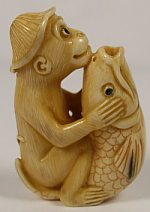
Monkey Holding Fish
Japanese Ivory Netsuke
Found at eBay 2004
|
|
 Sarumawashi (Saru Mawashi) Sarumawashi (Saru Mawashi)
From Artelino Art Auctions (artelino.com)
Sarumawashi is composed of the Japanese words saru (monkey) and mawashi (trainer). Sometimes it is written as Saru Mawashi. Sarumawashi are street performers, traveling from one place to another. They make a living by entertaining people with their trained monkey/s. Unlike Western civilizations, monkeys are a symbol of wisdom in Japan. Saru Mawashi are neither a legend nor a thing of the past. Even today, they can be found in Japan in crowded places making a living by showing performances of their trained monkey. Saru Mawashi performances are even shown on Japanese TV shows. <end quote by Artelino>
SMALLPOX CONNECTION
Sarumawashi no Ki
Quoted from story by Bernard Faure
Professor of Asian Religions, Stanford University
Monkeys were apparently used in some rites against smallpox. They were perceived as the messengers of the god Shoozenshin, a deity of Indian origin whose rite was allegedly transmitted to Japan by Bodhidharma. It is worth noting that the names of this god recalls that of Juuzenji, a Mt. Hiei deity who also had monkeys as emissaries. In rites against smallpox, one made a monkey dance (saru-mawashi) to determine whether the illness would be light or not. According to the Sarumawashi no Ki: “The main deity [honzon] of the sarumawashi is the first patriarch {Bodhidharma, Daruma}, and its protecting deity is Sarutahiko.” The apotropaic function of this rite is underscored by the Saruya Denki, which mentions a legend according to which Sarutahiko made monkeys dance in order to rout a demon army. <End quote by B. Faure. Click here to read the entire story.>
Hoso-Kami -- Japanese God of Smallpox
Below text courtesy of Centers for Disease Control
www.cdc.gov/ncidod/EID/vol8no7/v8n7cover.htm
www.cdc.gov/ncidod/eid/vol6no6/cover.htm
From Hartmut O. Rotermund (Hosogami ou la petite ve' role aise' ment, Paris, Maisonneuve Larose, 1991). The first record of smallpox in Japan was found in the Nihon Shoki, published in 735 (the 7th year of Tempyo). The incident was also described in Ishinho, the oldest medical book in Japan, issued by Yasuyori Tanba in 984 (the 2nd year of Eikan). Smallpox, called Hoso in Japanese, came to Japan in the same era as Buddhism. The disease was considered very dangerous. Even those who recovered could have pockmarks or loss of sight. Parents were constantly concerned about their children becoming ill with smallpox. The color red was used in prints and other smallpox illustrations because it was believed that Hoso-Kami, the god of smallpox, felt strongly about this color. When the skin rash was purple, the patient’s condition was considered serious. If the rash turned red, the patient would recover safely. Shoni-Hitsuyo-Yoikugusa, written by Gyuzan Kazuki in 1798 (the 10th year of Kansei), recommended that children with smallpox be clothed in red garments and that those caring for the sick also wear red. "Hoso-e" color prints against smallpox were used in prayers to boost the morale of ill children. After the patients recovered, these pictures were burned or floated down the river. Therefore, few examples are left of prints in which the color red predominates. The pictures drawn as protection against smallpox depicted heroic figures to give people courage against smallpox. Tametomo, a heroic samurai, was a representative genie. Legend has it that Tametomo was once banished to Hachijyo Jima, a small island far from main island in Japan, and that is why smallpox never occurred there. <end quote>

Smallpox Demon
Tametomo no bui toukigami wo shirizoku zu
Ukiyo-e woodcut print by Yoshitoshi, c. 1890
Naito Museum of Pharmaceutical Science & Industry
Hashima, Gifu, Japan. Photo found at this web site.


Jump to Page Four, Bibliography & Monkey Adages
|
|